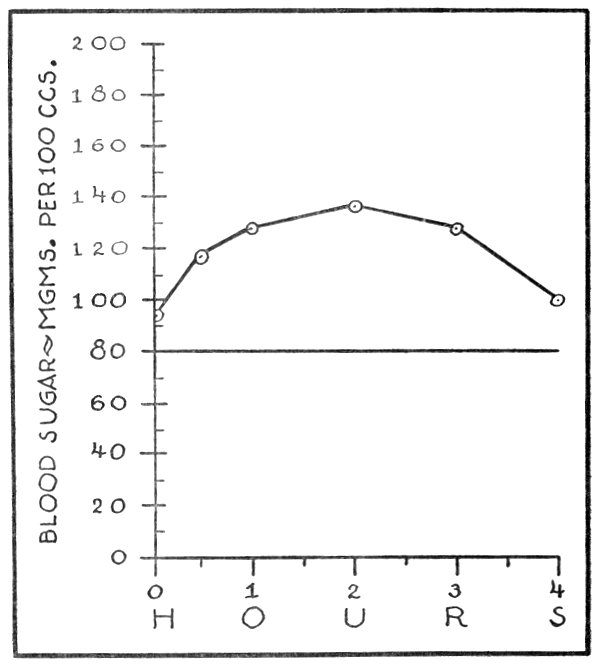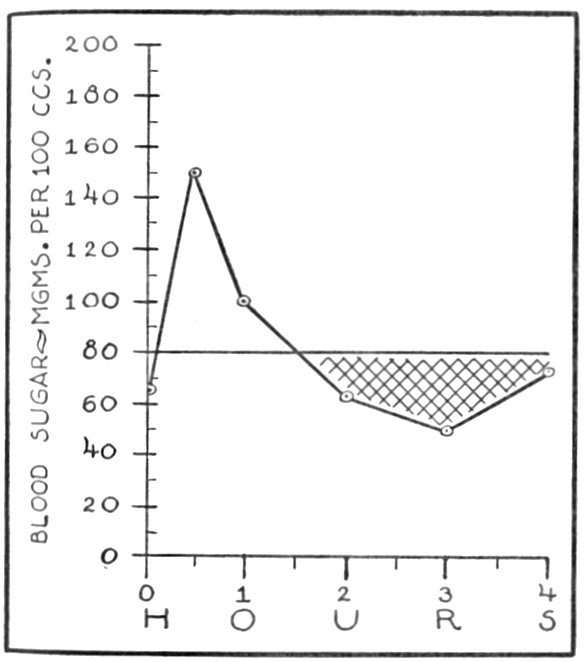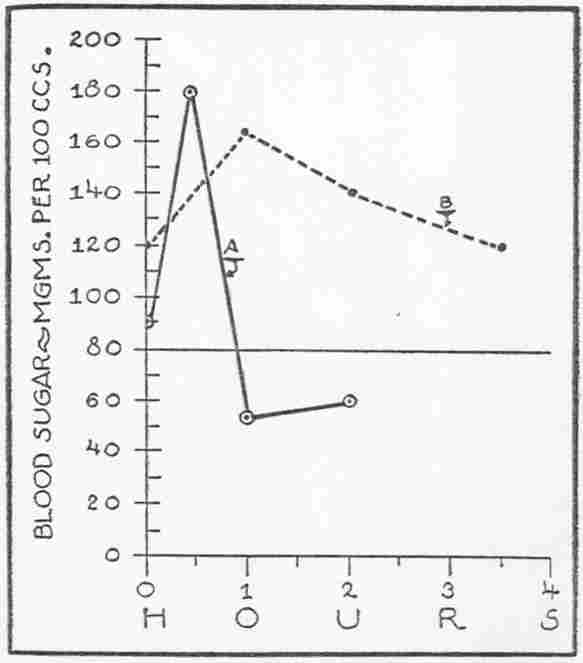
THE BLOOD SUGAR AND ITS REGULATION
Sugar is an essential constituent of the blood. It is also called "blood glucose." In the fasting state, as in the morning before breakfast, the blood sugar concentration is between 80 and 90 mg. per 100 cc. of blood. Even after several days of fasting the blood sugar will be maintained around this level in a well-nourished individual. It is essential to normal health that the blood sugar be maintained at this level, and that it should not fall below this level for periods longer than an hour. After a meal containing sugar the blood sugar rises at once, usually reaches a concentration of 120 to 140 mg. after 11/2 to 2 hours, and then gradually falls during the third and fourth hours to the previous fasting level. (Fig. 1.) In some individuals the blood sugar may reach 180 mg. and higher after a meal containing sugar, and, accompanying this high level, sugar may be found in the urine.
This abnormally high concentration of blood sugar is called in medicine Hyperglycemia (Hyper--excessive; Glycemia—blood sugar). The opposite state, an abnormally low blood sugar concentration, is called Hypoglycemia (Hypo—less; Glycemia— blood sugar). Fig. 2 shows the hypoglycemic type of curve, and Fig. 3 shows the hyperglycemic type of curve.
The maintenance of the blood sugar at normal levels is brought about by an efficient regulatory mechanism. The main organs in this mechanism are the liver, the autonomic nervous system, and certain glands of internal secretion called endocrine glands. The liver is at the center of this mechanism and serves as a storehouse of the blood sugar supply. The foods we eat are digested and broken down into simpler chemicals which are absorbed from the gastrointestinal tract, carried to the liver, and there built up (synthesized) by the liver cells into a complex compound called glycogen.

FIG. 1
Normal glucose tolerance curve. Subject drank a solution containing 100 grams of glucose. The blood sugar level rises gradually to a peak during the first two hours and then falls during the third and fourth hours to the previous fasting level. All blood sugar values lie well above the 80 mg. baseline.
In the fasting state glycogen is constantly being broken down in the liver cells into a simpler chemical called glucose or sugar which is then liberated into the blood stream at such a rate as to maintain the blood glucose level at around 80 mg. per 100 cc. This breakdown of liver glycogen is controlled chiefly by nerves of the autonomic system which consists of two divisions, the sympathetic and the parasympathetic.

FIG. 2
Low blood sugar (hypoglycemic) type of curve obtained after 100 grams of glucose. Note the sharp rise to 150 mg. at ½ hour followed by a sharp fall to abnormally low levels after 1½ hours. Note that the blood sugar remained at abnormally low levels for about 2½ hours. Hatched area indicates the extent and duration of the low blood sugar period.
The autonomic nervous system is so called because it is not under direct voluntary control; it regulates involuntary functions such as digestion, intestinal movements, the heart rate, the blood pressure, breathing, and body temperature.

FIG. 3
High blood sugar (hyperglycemic) type of curve obtained after 100 grams of glucose. Note sharp rise to around 250 mg. after 1 hour with rapid fall during the second and third hours. Individuals with this type of curve have symptoms resembling those seen in hypoglycemia and may also be susceptible to polio.
In general, the action of the sympathetic division is to facilitate and hasten the breakdown of liver glycogen with subsequent elevation of the blood sugar level, and the action of the parasympathetic division is to favor the synthesis and storage of liver glycogen. The two divisions are thus essentially antagonistic, and, at any moment, the blood sugar level will be the resultant of these two opposing forces.

FIG. 4
Glucose tolerance curves obtained in the monkey (curve A, after Jungeblut and Resnick) and in the rabbit (curve B, after du Vigneaud and Karr). Curve A, monkey: note wide fluctuation in blood sugar range with fall to low value of 50 mg. after one hour. Curve B, rabbit: note that all blood sugar values lie well above the 80 mg. baseline.
As for the endocrine glands, the important ones in blood sugar regulation are the pancreas and the adrenals, both of which are under the control of the pituitary gland. The pancreas secretes the hormone insulin which brings about the storage of glycogen and thus prevents the development of hyperglycemia. (Diabetes, a state of chronic hyperglycemia, is characterized by an insufficiency of insulin.) The adrenal glands produce a hormone called adrenalin whose action on the liver is to facilitate the breakdown of liver glycogen with subsequent elevation of the blood sugar. Adrenalin works in conjunction with the sympathetic nerves, and, since both produce the same effect, the two together are known as the adrenal-sympathetic system.
Since the heart of the blood sugar regulatory mechanism is the liver with its glycogen storage, and since glycogen is built up from the products of digestion, it becomes apparent that the amount of glycogen will depend on the nutrition of the individual. This is most important because it is the one factor that the individual can control.
In the fasting state glycogen is constantly being broken down into glucose because glucose is continually being removed from the blood stream since practically every organ in the body utilizes glucose as a source of energy. Glucose combines with oxygen, a process called oxidation, in order to provide the energy needed by the cells of the body to perform their particular functions. An important function of every cell is its ability to resist infection.
The body’s cells are working every moment of life and a steady supply of glucose must be supplied by the blood. The brain and spinal cord (which make up the central nervous system), the heart, the muscles, utilize glucose practically exclusively for energy purposes in performing their functions. A constant delivery of glucose is needed at every moment of life in order that such vital organs be adequately provided with their source of energy. These organs are never in a resting state.
The constant demand of the tissues of the body for glucose necessitates a constant source of supply. Failure of this supply mechanism may result in death. If the supply of glucose fails the body will draw on its own tissues (muscle and fat) to get glucose. Under such circumstances these tissues break down yielding split-products which are synthesized to glycogen in the liver and then paid out as glucose into the blood. If this state is prolonged, weight loss results with eventual emaciation. This mechanism explains the weight loss and emaciation that often accompany worry and anxiety states. In these states the individual loses his appetite, becomes malnourished, and draws on his own tissues to maintain blood sugar levels.
I wish to emphasize the fact that the blood sugar supply to the central nervous system is particularly important. The blood sugar must not only be supplied continuously, but must also be maintained at optimum level, around 80 mg. per 100cc. ‘When the blood sugar falls below 80 mg. certain organs, especially the nervous system, will be embarrassed and signs and symptoms of disturbance in function make their appearance. The severity of the signs and symptoms will depend on how low the blood sugar falls.
When the blood sugar falls to 60 to 70 mg., symptoms are usually mild and may consist of slight headache, faintness, muscular weakness, hunger, irritability, and perhaps a feeling of nervousness or tension.
When the blood sugar falls to 50 to 60 mg., the symptoms are more marked and will consist of headache, dizziness, unsteady gait, faintness, weakness, fatigue, marked irritability, pallor, sweating, tremors, palpitation, and general nervousness.
If the blood sugar falls to 40 mg. or lower, unconsciousness usually occurs. This unconsciousness is exactly like that seen in the ordinary fainting spell and is usually accompanied by pallor, sweating, and feeble, rapid pulse. Recovery from such faints is usually spontaneous and is brought about by a rise in blood sugar which occurs as a protection against further fall in blood sugar level. The abnormally low blood sugar level stimulates certain centers in the central nervous system, and from these centers impulses go out over the sympathetic nerves to the liver with a resultant increase in breakdown of liver glycogen and subsequent rise in blood sugar.
At the same time the adrenal glands respond to the fall in blood sugar by an increased output of adrenaline into the blood. The adrenaline acts upon the liver to step-up the breakdown of glycogen so that more glucose will be liberated into the blood. The effects of this adrenal-sympathetic stimulation with rise in blood sugar level brings about spontaneous recovery from the unconscious state. The cells of the brain now receive normal amounts of sugar and resume their normal function.
The hypodermic injection of adrenalin will also hasten recovery because the injected adrenalin has the same effect upon the liver as the body’s adrenalin. The common practices of applying cold water to the head, the inhalation of vapors of spirits of ammonia, and vigorous rubbing of the skin, hasten recovery from simple faints because these measures can likewise cause stimulation of the adrenal-sympathetic system.
If the adrenal-sympathetic response is weak, recovery may be slow; if it is absent, recovery will not occur and death ensues. If the adrenal-sympathetic response is adequate, but the liver glycogen storage deficient, the blood sugar may not be restored to normal levels simply because there is not enough glycogen available. Such deficient storage will result from poor nutrition.
Summarizing, it is evident that the blood sugar must be maintained at 80 mg. for normal bodily function, and that symptoms appear if the blood sugar falls below this level. These symptoms will be mild, moderate, or severe, depending on how low the blood sugar falls. Spontaneous recovery from low blood sugar results from adrenal-sympathetic stimulation of the liver with subsequent rise in blood sugar. Recovery from low blood sugar will thus depend chiefly on (1) an adequate protective response by the adrenal-sympathetic mechanism and (2) the amount of glycogen stored in the liver which, in turn, will depend on the nutritive habits of the individual.